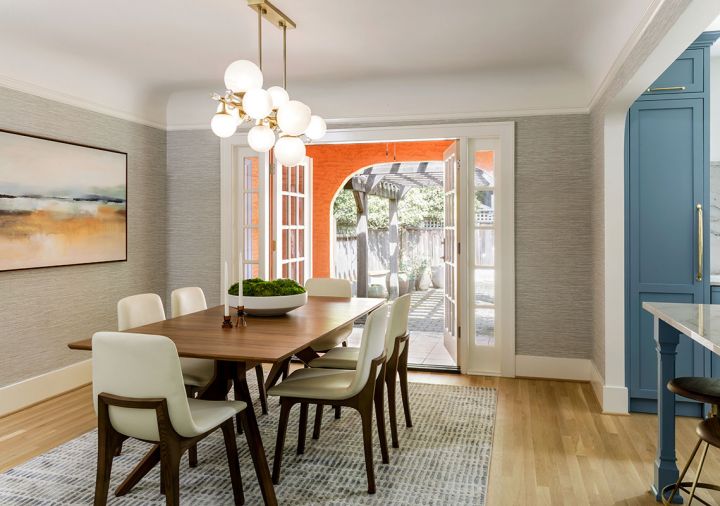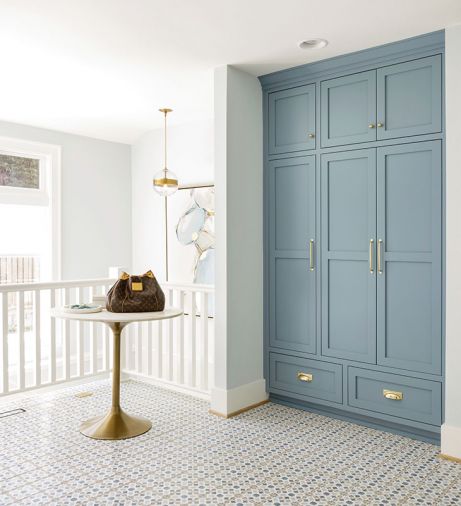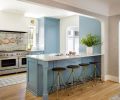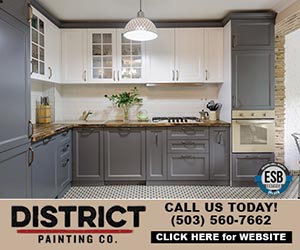The Stanleys thought they would replace some cabinets and tiles in their kitchen damaged by a water leak. “As we got into things with our contractor, Scott Wacker of Wacker Remodel, the scope started to grow,” recalls Jeremy Stanley. “It became apparent that we needed someone to help us bring a bigger vision to life.” Wacker recommended Charla Ray Interior Design. It was the right move.
The first thing Ray recommended was bringing some visual and functional balance to the kitchen. The sink and stove were jammed up together; there was very little natural light and even less useful counter space. “The kitchen is the first thing you see when entering the front door. It sets the tone for the whole home,” said Ray. A plan was hatched to maximize the kitchen’s small footprint without heavy structural changes. The impressive Blue Star Range from Eastbank Appliances serves as the focal point. New Marvin windows from Portland Millwork and an enlarged peninsula with additional seating contribute to a bright and inviting view upon entry.
“Scott and I have worked on several projects together,” said Ray. “I appreciate how open he is to finding solutions to new challenges and supporting design choices with high-quality execution.” Careful space planning and cabinetry design were pivotal to support a more efficient work triangle, create more prep spaces, and maximize the smaller footprint.
A prior addition to the home left a small room with limited use other than as a pass-through to access steps down to the basement and garage. Ray re-envisioned this pace as a highly functional “drop zone,” including a massive new pantry. Ray replaced the kitchen’s busy old tiles with new wood floors, feathering them into the dining room’s wood and refinishing all for cohesion. Light fixtures from Arteriors complement each other across kitchen, dining, and pantry areas. The new kitchen, pantry room, and dining room allowed the family to make aesthetic sense of the home’s Mediterranian roots and their own predilection to mid-century modern style.
“We wanted to do something with the kitchen that respected the 100-year-old Mediterranean-style house but worked with our preferred mid-century aesthetic and furniture. Plus, we didn’t want a kitchen that would eventually feel dated,” said Stanley. “In this regard, Charla worked magic.”
Overall, Ray’s approach was to anchor the design in classic kitchen features like flush inset cabinets, timeless hardware, traditional windows, wood flooring, all complementing the home’s history. Then, by adding more modern touches in the styling of furniture and lighting, the spaces harmonize with the occupant’s more modern preferences. Even the artwork was carefully considered to pull seemingly disparate elements together like color and shape.
“Working with Char was fantastic,” said Stanley. “She helped us to understand what was and wasn’t possible given our space, budget, and potentially conflicting desire to bridge our modern tastes with the more traditional style of the home.”
PROJECT SOURCES
CONTRACTOR
Wacker Remodel LLC
wackerremodel.com
INTERIOR DESIGN
Charla Ray Interior Design
charlaray.com
APPLIANCES
Eastbank Contractor Appliances
eastbankappliance.com
Vent-A-Hood
luwaluxury.com
WINDOWS
Portland Millwork
portlandmillwork.com
PAINT
Benjamin Moore
benjaminmoore.com
Shoptalk - Charla Ray

Charla Ray, Founder | Charla Ray Interior Design
What aspects of your background and upbringing have shaped your design principles and philosophies?
I grew up on a Montana farm and ranch. The home I spent most of my childhood in was a fixer, and we improved it over time. That house was short on usable space, so I do think it shaped a philosophy of maximizing functionality and organization. I’ve always had an innate desire to make things beautiful. Now I know that a great design does not sacrifice function to have beauty, or sacrifice beauty to have function. It’s a balance.
What was the “lightbulb” moment when you realized you wanted to pursue interior design?
I was interested in architecture but playing basketball for Montana State. I was advised against combining the two. After graduating with a business degree, I started selling real estate. We were matching buyers with fabulous rural parcels we had listed, and then facilitating with high end builders we had relationships with. So, I had a lot of exposure to the building process, and very organically clients started asking more and more for my input. I loved the combination of design and helping people, and I was starting to realize that the ability to envision and understand space was intuitive to me, but an enigma to most. I decided to go back to school and get a second bachelor’s degree (in interior design) at The Art Institute of Portland.
How do you describe your design style?
I want people to feel content and at ease in every space I design. My design style is very much client driven. My objective is to create something that speaks to them and relates to the vernacular of the neighborhood, architecture, etc. My personal design style is clean lined, textural, and layered. I think these elements are commonalities in my projects.
How do you stay inspired?
I stay inspired by going to design furnishing markets like High Point and Las Vegas. The Kitchen and Bath Industry Show (KBIS) is amazing, and I try to go every year. I’m also inspired by nature. Right now (Fall) the leaves and landscape are just brilliant.
Favorite design or architectural detail of your childhood home?
The fixer home I referenced above was an A-frame with 30' high wood tongue and groove ceiling, and wall of windows, plus a giant rock fireplace. The house was fraught with space planning issues from the original builder, but I came away with a love of volume, natural light, and natural materials.
Do you have a dream project, or location where would you like
to work?
Working on a home at the Yellowstone Club, which is an amazing exclusive community outside of Bozeman, MT.
In your opinion, what is the most fundamental element of interior design? Where do start on a new project?
I think it is the relationship between the home and the people using the space. A new project starts with a lot of conversation with the clients and understanding them, thinking about how they live and how to design a space to really support them. I’m looking at it from the standpoint, “ok, I know it’s going to be beautiful, but how can we make this a space that really rises up to meet you.” Again, that balance of beauty and function.
Your work has been featured in Better Homes and Gardens, on Portland’s Tour of Remodeled Homes, and on numerous blogs and social media platforms, are there any recognitions you are most proud of?
Being featured in a beautiful magazine like Portrait Magazine is certainly a great honor. I think the recognition I’m most proud of is that which comes from clients. Not just in the form of repeat and referral business, but more importantly, it’s the lasting friendships.












